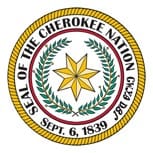
VINITA, Okla. – Cherokee Nation Principal Chief Chuck Hoskin Jr. announced Wednesday new investments in cultural preservation through the acquisition of two historic homes.
The announcement was made during a presentation to the Vinita Rotary Club and includes the homes of former Chiefs Thomas Buffington in Vinita and J.B. Milam in Claremore.
“Preserving Cherokee history is paramount to understanding and appreciating the rich tapestry of our people in northeast Oklahoma,” Chief Hoskin said. “Acquiring these historic homes and bringing them into the fold of our cultural tourism mission allows us to properly honor the legacies of Chief Buffington and Chief Milam. Both these men were admirable leaders and played significant roles in defending and building our tribal nation during vulnerable chapters in Cherokee Nation history.”
Chief Buffington was born in the Goingsnake District of Cherokee Nation in 1855 and began his first term as Principal Chief in 1891 after the passing of Principal Chief Joel B. Mayes and Second Chief Henry Chambers. He was a Cherokee delegate to Washington during negotiations of the Curtis Act and later served again as Principal Chief from 1899 to 1903. He also served as mayor of Vinita several times and engaged in ranching and the oil business.
His 2,800-square-foot home in Vinita was built in 1902 and is where he lived until his passing in 1938.
The acquisition of the Chief Buffington home was the vision of Cherokee Nation First Lady January Hoskin.
“The Chief Buffington home is such a beautiful home of such enduring historic significance,” said First Lady Hoskin. “I’m excited to see our restoration efforts and a plan to make the home a wonderful complement for cultural tourism with the nearby Anna Mitchell Cultural Center.”
Chief Milam was born in the Cooweescoowee District of Cherokee Nation in 1884. During an era in which the United States government worked to weaken the sovereignty of tribal nations, he was appointed Principal Chief of the Cherokees by two different U.S. presidents in the 1940s. Although he was not in an elected position, Milam used his time in office to serve his people and help lay the foundation for the modern Cherokee Nation.
His 3,730-square-foot home in Claremore was built in 1941 and served as his home and office where he oversaw many of the governmental affairs of the Cherokee Nation while the government was without an official tribal headquarters.
Chief Hoskin credited former Councilman Keith Austin with identifying the Milam home as a potential acquisition during his time representing District 14, which includes Claremore. Austin now serves as a cultural tourism advisor for Cherokee Nation Businesses.
“Chief Milan served during such a pivotal time in Cherokee history,” said Austin. “His home can be a place to help tell his story, explore concepts of tribal self-governance and perhaps serve as a resource for our partnerships with nearby Rogers State University.”
While no official plans for the homes were shared at the meeting, discussion surrounding their future is centered on protection and preservation, with hopes of sharing more about the life and legacy of each former Chief.




